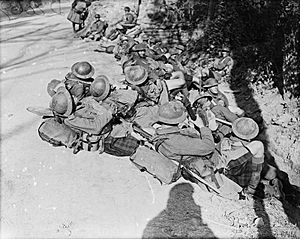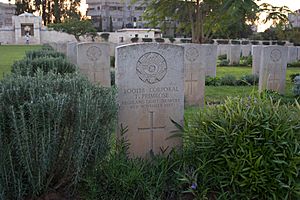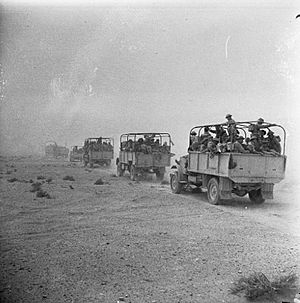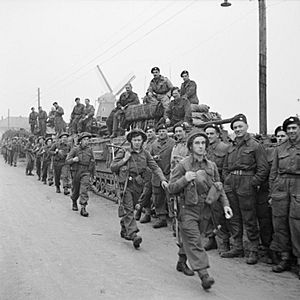Highland Light Infantry facts for kids
Quick facts for kids Highland Light Infantry (City of Glasgow Regiment) |
|
|---|---|
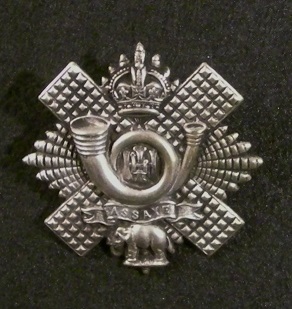
Cap badge
|
|
| Active | 1881–1959 |
| Country | |
| Branch | |
| Type | Infantry |
| Role | Light infantry |
| Part of | Highland Brigade |
| Garrison/HQ | Hamilton Barracks (1881–1921) Maryhill Barracks, Glasgow (1921–1959) |
| Nickname(s) | "Hell's Last Issue" The regiment was nicknamed 'The Glesga Keelies' during the Peninsular Wars. |
| March | Quick- Sean Triubhas (Whistle o'er the Lave o't) Slow - Garb of Old Gaul |
| Mascot(s) | Elephant |
| Anniversaries | Assaye (September 23) |
| Insignia | |
| Hackle | White |
| Tartan | MacKenzie Tartan |
The Highland Light Infantry (HLI) was a special army group known as a light infantry regiment in the British Army. It was formed in 1881. This regiment played a big part in both the First and Second World Wars.
In 1959, the HLI joined with another regiment, the Royal Scots Fusiliers. They formed a new group called the Royal Highland Fusiliers (Princess Margaret's Own Glasgow and Ayrshire Regiment). Later, this new regiment became part of an even bigger group called the Royal Regiment of Scotland.
History of the HLI
How the Regiment Started
The Highland Light Infantry was created on 1 July 1881. This happened as part of big changes in the army. Two older regiments, the 71st (Highland) Light Infantry and the 74th (Highland) Regiment of Foot, joined together. The HLI became the main army unit for the city of Glasgow.
Even though it was called "Highland," the regiment mostly recruited soldiers from Glasgow. This city is in Lowland Scotland, not the Highlands.
Early Battles and Service
The 1st Battalion of the HLI went to South Africa in October 1899. They fought in the Second Boer War. After that, they were stationed in Egypt in 1902.
The 2nd Battalion fought in the Battle of Tell El Kebir in Egypt in 1882. During this battle, Lieutenant William Edwards showed great bravery. He was awarded the Victoria Cross, a very special medal for courage. The battalion then moved to India in 1884.
During the Boer War, many reserve army groups were called to action. This included the 3rd Battalion of the Highland Light Infantry. They served throughout the war.
In 1908, the army changed how it organized its volunteer and reserve forces. The HLI then had two reserve battalions and five volunteer battalions.
The First World War (1914-1918)
The Highland Light Infantry fought bravely in many important battles during the First World War. Different parts of the regiment served in various locations.
Regular Army Battalions
The 1st Battalion went to France in December 1914. They fought on the Western Front. Key battles included the Defence of Festubert and the Battle of Neuve Chapelle. Later, they moved to Mesopotamia (modern-day Iraq) and fought in the Siege of Kut.
The 2nd Battalion also went to the Western Front in August 1914. They were involved in major battles like the First Battle of the Aisne and the First Battle of Ypres. They also fought in the Battle of the Somme in 1916 and the Battle of Cambrai in 1917.
Volunteer Battalions
Several volunteer battalions, like the 1/5th, 1/6th, and 1/7th, landed in Gallipoli in July 1915. This was a tough campaign. After being moved to Egypt, they later joined the fighting on the Western Front. The 1/9th Battalion also served in France from November 1914.
New Army Battalions
Many new battalions were formed for the war. The 10th and 11th Battalions arrived in France in May 1915. The 12th Battalion followed in July 1915.
The 15th, 16th, and 17th Battalions also arrived in France in November 1915. The 16th Battalion was special because it was made up of former members of the Glasgow Boys' Brigade. This battalion is remembered for its incredible bravery at the Frankfurt trench during the Battle of the Ancre. Around 60 men were surrounded by the enemy but refused to give up. They fought until only 15 wounded men were left. Their courage was praised by a top general.
The 18th Battalion also arrived in France in February 1916.
Between the World Wars
In 1923, the regiment's name was made longer to Highland Light Infantry (City of Glasgow Regiment). A famous actor, David Niven, was an officer in the regiment in 1930.
The Second World War (1939-1945)
The HLI continued to play a vital role in the Second World War.
The 1st Battalion went to France in September 1939. They were part of the British Expeditionary Force. They took part in the famous Dunkirk evacuation in June 1940, where many soldiers were rescued from France. Later, they fought in the Normandy landings in June 1944. They also saw action in the Battle of the Bulge and the final push into Germany.
The 2nd Battalion moved to Egypt early in the war. They fought in the Battle of Keren in 1941. They also saw combat in the desert at the Battle of Knightsbridge and the Battle of Fuka. They were part of the Allied invasion of Sicily in 1943 and later fought in Italy.
The 5th and 6th Battalions landed in France in June 1940. After being evacuated, they later landed in Belgium in October 1944. They helped capture Bremen in Germany in April 1945.
The 11th Battalion changed its role in 1942. It became a tank unit, but the soldiers still wore their Highland Light Infantry badges.
After the Wars
In 1959, the Highland Light Infantry officially joined with the Royal Scots Fusiliers. They formed the Royal Highland Fusiliers. This marked the end of the HLI as a separate regiment.
Uniform and Appearance
The Highland Light Infantry had a very unique uniform in 1914. They wore a dark green hat called a shako with green cords. Their jacket, called a doublet, was scarlet with buff-colored parts.
Instead of the traditional Scottish kilt, the HLI wore trews. Trews are trousers made from tartan fabric. The HLI was the only regular Highland regiment to wear trews for their full dress uniform. This changed in 1947 when kilts were allowed.
Battle Honours
Battle honours are special awards given to regiments for their bravery and success in battles. They are proudly displayed on the regiment's flags, called colours.
The HLI had many battle honours from its history:
- From battles fought before 1914: "Assaye", "Cape of Good Hope 1806", "Corunna", "Waterloo", "South Africa 1899-1902".
- From the First World War: "Mons", "Ypres 1914,'15,'17,'18", "Loos", "Somme 1916,'18", "Gallipoli 1915–16".
- From the Second World War: "Odon", "Scheldt", "Rhine", "Reichswald", "North-West Europe 1940, '44-45", "Keren Cauldron", "Landing in Sicily".
Important Leaders
Colonels-in-Chief
The Colonels-in-Chief were important honorary leaders, often members of the Royal Family.
- 1901–: F.M. Arthur William Patrick, 1st Duke of Connaught & Strathearn
- 1947–: Princess Margaret, Countess of Snowdon
Regimental Colonels
These were the main military leaders of the regiment over the years.
- 1881–1888 (1st Battalion): Gen. John Hamilton Elphinstone Dalrymple
- 1881–1901 (2nd Battalion): Gen. Walter Douglas Phillips Patton-Bethune
- 1901–1903: Lt-Gen. William Kelty McLeod
- 1903–1916: Gen. Sir Henry John Thoroton Hildyard
- 1916–1918: Lt-Gen. Sir William Pitcairn Campbell
- 1918–1921: Lt-Gen. Sir David Henderson
- 1921–1929: Maj-Gen. Granville Egerton
- 1929: Gen. Sir Henry Horne, 1st Baron Horne
- 1929–1936: Brig-Gen. Sir Alfred Granville Balfour
- 1936–1946: Maj-Gen. Sir Andrew Jameson McCulloch
- 1946–1954: Maj-Gen. Alexander Patrick Drummond Telfer-Smollett
- 1954–1957: Maj-Gen. Robert Elliott Urquhart
- 1957–1959: Maj-Gen. Ronald Albert Bramwell Davis


